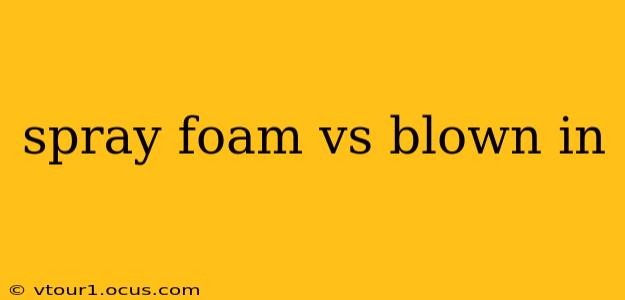Choosing the right insulation for your home is a crucial decision impacting energy efficiency, comfort, and long-term costs. Two popular options often top the list: spray foam insulation and blown-in insulation. Both offer excellent thermal performance, but their application methods, properties, and suitability vary significantly. This in-depth comparison will help you determine which option best fits your needs.
What is Spray Foam Insulation?
Spray foam insulation is a two-part liquid mixture that expands and hardens upon application. It creates an airtight seal, filling all gaps and cracks to effectively block air infiltration. There are two main types: open-cell and closed-cell.
- Open-cell spray foam: Less expensive, it offers good insulation but allows for some moisture vapor transmission. It's often used in less critical areas.
- Closed-cell spray foam: More expensive, it provides superior insulation and a complete vapor barrier, preventing moisture from entering the wall cavity. It's ideal for basements, attics, and other areas prone to moisture.
What is Blown-in Insulation?
Blown-in insulation, typically made of fiberglass or cellulose, is installed using specialized machinery that blows the material into walls, attics, or crawl spaces. It's a more cost-effective option than spray foam, especially for larger areas. The material settles and conforms to the existing structure.
- Fiberglass: A common and relatively inexpensive choice, it offers good insulation properties but may settle over time, requiring periodic re-installation.
- Cellulose: Made from recycled paper, it provides excellent insulation and sound dampening properties. It's also a more environmentally friendly option.
Spray Foam vs. Blown-in: A Detailed Comparison
Here's a head-to-head comparison highlighting the key differences between spray foam and blown-in insulation:
| Feature | Spray Foam (Open-cell & Closed-cell) | Blown-in (Fiberglass & Cellulose) |
|---|---|---|
| Cost | Higher | Lower |
| Installation | More complex, requires specialized equipment and skilled installers | Relatively simpler, faster installation for larger areas |
| Air Sealing | Excellent, creates an airtight seal | Fair to good, depending on application and skill of installer |
| Moisture Control | Excellent (closed-cell), fair (open-cell) | Fair to good, may require additional vapor barriers |
| R-value | High (especially closed-cell) | Good, but may decrease over time due to settling |
| Durability | Very durable, long lifespan | Moderate durability, may settle and require re-installation |
| Environmental Impact | Varies, some foams have higher VOCs | Generally more environmentally friendly, especially cellulose |
| Sound Dampening | Good | Good (especially cellulose) |
How Much Does Spray Foam Insulation Cost?
The cost of spray foam insulation varies depending on several factors, including the type of foam (open-cell or closed-cell), the area to be insulated, and the installer's labor costs. Generally, spray foam is more expensive than blown-in insulation. Expect to pay a higher upfront cost.
How Much Does Blown-in Insulation Cost?
Blown-in insulation is generally more affordable than spray foam. The cost will depend on the type of material (fiberglass or cellulose), the amount needed, and the installer's labor charges.
Which Insulation is Better for Soundproofing?
Both spray foam and blown-in cellulose insulation offer excellent sound dampening properties. However, cellulose generally performs slightly better at reducing noise transmission.
Which Type of Insulation is Best for My Attic?
For attics, both spray foam and blown-in insulation are viable options. Closed-cell spray foam provides superior air sealing and moisture control, making it ideal in climates with high humidity or extreme temperatures. Blown-in cellulose offers a cost-effective alternative with good insulation and sound dampening qualities.
Which Insulation is More Energy Efficient?
Both spray foam and blown-in insulation significantly improve a home's energy efficiency. However, closed-cell spray foam generally boasts higher R-values, leading to better thermal performance and reduced energy bills in the long run.
Which is Better for a Basement?
For basements, closed-cell spray foam is often the preferred choice due to its superior moisture resistance and air sealing capabilities. Basements are prone to moisture, and closed-cell spray foam helps prevent mold and mildew growth.
Conclusion
The "best" insulation depends heavily on your specific needs, budget, and climate. Spray foam, particularly closed-cell, provides superior performance in terms of air sealing, moisture control, and R-value but comes at a higher cost. Blown-in insulation, especially cellulose, offers a more economical alternative with good insulation and environmental benefits. Consult with a qualified insulation contractor to assess your home's unique requirements and receive a professional recommendation tailored to your situation. They can help you weigh the pros and cons and choose the most suitable option for your home.
